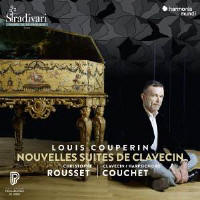Texte paru dans: / Appeared in: |
|
|
Outil de traduction ~ (Très approximatif) |
|
|
Reviewer: Barry
Brenesal Louis Couperin has certainly not lacked for champions in recent years. However, most of those who record a fair sampling of his music move on to other pastures afterwards, never to look back. Christophe Rousset is an exception. This two-disc set follows eight years after another, issued by Aparté, and reviewed in Fanfare 34:3 by Christopher Brodersen. He was very impressed, concluding, “This release may not be for everybody, but for devotees of French harpsichord music, it is well-nigh indispensable.” My reactions at the time were generally positive, if not quite as enthusiastic. Rousset was, as ever, an insightful and exciting performer, but inclined at times to push tempos and forego ornamentation.
His new release, which shares
a few suites with the former, leaves me with more reservations. Chief among
these is Rousset’s approach to the preludes. It is an amalgam of very fast
tempos with drawn out pauses that often sound arbitrarily placed, without
regard to moments of harmonic change. Nor do his faster tempos provide
sufficient space for ornamentation. These difficulties are worsened by the
use of a fine harpsichord—a 1652 Johannes Couchet, which underwent a
moderate ravalement in 1701—with a fairly lengthy decay. For me, at least,
this results not infrequently in fast passagework that creates a jumble of
unresolved dissonances. There’s nothing wrong, of course, in using precisely
this approach to supply a bold dissonance, and both the 17th-century
Italians and 17th- and 18th-century French did just that. (John Kitchen,
performing a toccata by Michelangelo Rossi on a Florentine chromatic
harpsichord dating from the turn of the 17th century on Delphian 34057,
illustrates this well.) But they managed it with careful forethought, as a
pinch of harmonic spice. Rousset’s version of the preludes upend the spice
cabinet.
A comparison with that earlier
recording of Couperin’s suites by Rousset demonstrates much the same mix of
overly fast passages and over-extended pauses. But the harpsichord (a 1658
double manual Denis) he used had a slightly faster decay, and Rousset seven
years ago was more inclined to deploy his application of agogics around
harmonic shifts. There was greater coherency as a result. The various dances in the suites are handled in a more straightforward fashion. If anything, I find them in general a bit lacking in nuances of phrasing, which Rousset can’t apply due to the faster tempos he uses. This is clearly a matter of preference; and my preference lies here with the more moderated tempos applied to the dances in Richard Egarr’s traversal of Couperin’s oeuvre (Harmonia Mundi 907511-14, reviewed in Fanfare 35:4). In the Suite in D Major, for instance, the Allemande, Courante, and Gaillarde all proceed at a slighter slower pace in Egarr, which allows him to stretch time at will. Not so, the Sarabande—yet that’s exactly where Rousset slows down for one of the more expressive moments in his set. The final chaconne is treated with gravity and charm by Egarr, but Rousset performs the recurring main melody almost as an assertive march, its episodes more reflective, which emphasizes the rondeau aspect of the piece. Much the same points can be made about the rest of this album. In short, it would not be my first pick to give to someone who is unfamiliar with Louis Couperin’s works. The dances are for my taste usually a bit bland and too quickly paced, while the preludes proceed counterintuitively. On the other hand, preludes aside, this and Rousset’s earlier release furnish an intriguing alternative to what we might call this music’s standard interpretative stance. | |
|
|
|
|
|
|
|
Cliquez l'un ou l'autre
bouton pour découvrir bien d'autres critiques de CD |
|




